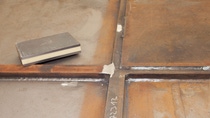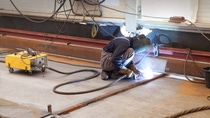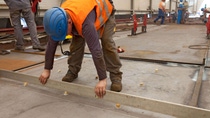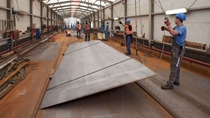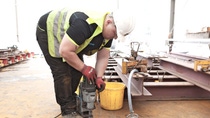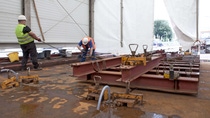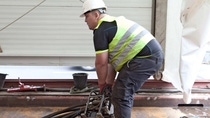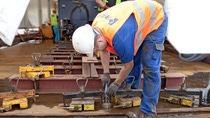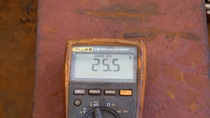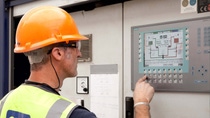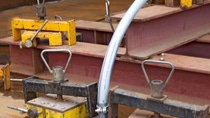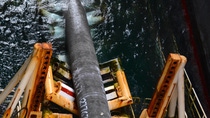Construction
Dependable connection
Bridge refurbishment is urgently required in many places – but closures for building work puts pressure on the surrounding infrastructure. A current project in Luxemburg shows that there is an alternative.
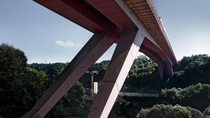
Luxemburg, the tiny country in the heart of Europe, has a vibrant, diversified and multifaceted capital of the same name. Luxemburg City is not only a well-known banking and finance center, but also the region’s cultural focus. It is here that everything comes together, for this is the country’s commercial, social, and touristic nerve center. And it is a traffic hub. But this is not all, as it is also a neuralgic spot that depends on traffic systems functioning flawlessly. So what happens when one of the most important traffic arteries linking the Old Town with the European institutions on the Kirchberg Plateau doesn’t live up to the requirements of the current traffic situation? This is now the case with the so-called Red Bridge or “Pont Rouge”, officially known as the Pont Grande-Duchesse Charlotte, a 355-meter-long steel bridge dating back to 1965 that spans the Alzette River and the Pfaffenthal quarter at a height of 74 meters.
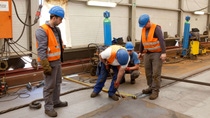
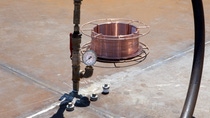
2: When the liquid PU mix is being poured in, the filling level is constantly monitored.
Impressive structure, unusual refurbishment
There’s no doubt that the Pont Grande-Duchesse Charlotte is an impressive bridge structure. However, refurbishment is necessary not least because of its severe stressing and to meet the demands on durability and lastingness for the next decades. And this is also a fine opportunity for reviewing its overall concept. The six-lane carriageway will be reorganized into four lanes for car traffic and two for a streetcar so that it can handle the high volume of traffic better and foster the use of public transport. The pedestrian and cycle paths on both sides will be widened and the existing Plexiglas barrier of the railing replaced by a metal grille construction which in addition is illuminated with LED lights.
This is a large-scale and time-consuming upgrade that also has to be performed with moving traffic. Thomas Stihl, Division Manager for systems bridges at SEH, outlines the problem: “Renovating bridges of this size poses major difficulties, and conventional strategies usually result in bridge closure.” It is such situations that call for a very special solution: SPS, the innovative Sandwich Plate System.
SPS – a technology makes its mark
SPS, a composite of steel and a polyurethane core, has been in successful use for about 20 years. The applications cover offshore platforms, ships’ decks, high-rise floor slabs, metro and suburban railroads, and bridges. And that’s by no means the complete list of possible uses. Over the years, the steel-polyurethane-steel sandwich has proven to be an indispensable element in many structural areas. Particularly if it’s a question of sustainability, strength, weight reduction, feasibility, and cost management. And now, in the refurbishment of the Red Bridge in Luxemburg, SPS has yet again demonstrated the potential of the sandwich principle.
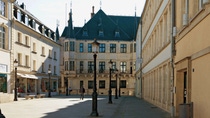
Christof Grieser-Schmitz, SPS Project Leader and Head of Infrastructure at BASF, explains the technology: “SPS is not only stronger and less expensive than most other carriageway systems but using SPS makes major reductions in bridge weight possible.” At the same time, the solid polyurethane core audibly diminishes the otherwise usual traffic noise, as there is no longer a resonator typical of steel structures. Polyurethane acts like a damper. In terms of service life, the polyurethane-steel sandwich is decades better than other technical solutions. Michael Kennedy, President of Intelligent Engineering, is convinced of the system’s technological and economic superiority: “It’s taken several years for the idea to get established, but our technology will transform the future of construction.” One thing is certain: In terms of speed, flexibility, durability, and cost-effectiveness, SPS is a revolutionary idea for structural steel engineering that no other material can match.
SPS is not only stronger and less expensive than most other carriageway decks, but it is also capable of reducing bridge weight considerably.
How long has SPS been around?
At Carleton University in Ottawa, a research project into the development of ice barriers to protect offshore installations in the Arctic Beaufort Sea was initiated in 1993. It was in this context that Stephen Kennedy, the “inventor” of SPS, hit upon the idea of producing a load-bearing composite of steel and plastic capable of withstanding the impacts of ice floes in choppy seas.

What is SPS?
The Anglo-Canadian firm Intelligent Engineering was created to market this idea. Together with BASF, it developed a plastic that, in a single load-bearing element, combines the characteristic advantages of steel structures with the additional physical properties resulting from the marriage of steel plates with plastic. The outcome was SPS, an element of two steel plates sandwiching a solid polyurethane core. This alternative composite material is capable of replacing conventional construction methods that use concrete or steel. Without its inventors’ vision and perseverance, SPS would never have seen the light of day. And modernizing the Pont Rouge in Luxemburg with ongoing traffic flow would never have been possible.
A bridge to the future
Sandwich Plate System (SPS) for Pont Rouge, Luxemburg
Related articles
Consult with an expert
Self-service solutions:
